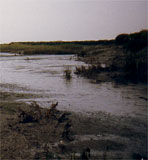| Contact us |
| Try wildfowling |
| Club merchandise |
| Wildfowl art |
| Wildfowling books |
| Join KWCA |
| Search |

Safety - Weather
Dangers
From the cold.
On some of our marshes you may be cut off by the
tide for up to nine hours. In the middle of January with temperatures
below zero that is an extremely long time. So make sure that you take
with you hot drink, some food and of course plenty of warm clothing. Cold
hands and feet should never be allowed to numb, exercise them regularly
to promote circulation.
Take good care of your dog. Try to avoid long swims in icy water and dry
the dog off after each retrieve. Frozen mud is the most unpleasant seat
for your dog. Just one quarter of a bail of straw will provide ample material
to make a warm dry comfortable bed.
Snowstorms can be great fun to shoot in but remember were you have parked
your car. Drifting snow will quickly block roads and tracks across the
marshes leaving you stranded.
From the heat.
We can still experience very hot days in early September. Dehydration
can be a problem so take plenty of water for you and your dog. Sunburn
and the risk of skin cancer are very real dangers to anyone engaged in
outdoor activities. Wear a hat, cover arms and use sun-blocking creams
on exposed skin. Warm weather brings out clouds of blood sucking midges
and mosquitoes, while they present no risk to health they can make your
day most unpleasant. Choose a good insect repellent.
Dogs die in hot cars.
Do not under any circumstance, leave your dog in a car that is exposed
to the sun, even in winter. The temperature inside can soar in a matter
of minutes.
From the tide. See Killer
Storm Surge
The weather can have a dramatic effect
on the height of the tide. We say dramatic and we mean dramatic, it is
the difference between you going out and having a very enjoyable days
wildfowling and you going out and ending up dead!
Three weather conditions will cause the tide to differ from prediction.
A strong wind from the North, anywhere between North West and North East
will blow surface water down the North Sea and as the North Sea narrows
that water has nowhere to go but into our estuaries, up our rivers and
up comes our tide.
Conversely a strong wind from the South anywhere from South East to Southwest
will blow the surface water up the North Sea and we will get a much lower
tide than predicted. Beware when that wind stops because all the water
that been blown up the North Sea comes surging back down into our estuaries.
When atmospheric pressure is low, there is less pressure hold the water
down, so up it comes. Just a one inch fall on the barometer will cause
a 14-inch rise in the height of the tide in the Medway.
The worst scenario
In the worst possible scenario Northerly gales follow a Southerly gale
driven by a low pressure system coinciding with a high spring tide can
bring catastrophic tidal surges in excess of 2 metres. Watch out for this
surge tide. If you do not see it coming one day it will catch you out!
KWCA members can access detailed weather information through the members
section of the site.
See the met office 5 day forecast: East Malling 5 day forecast